Green River Rendezvous Days 2013 Update
The material in this section describes the Three Worlds Meet theatrical and scholarly presentations that took place during the Green River Rendezvous Days in Pinedale, Wyoming on July 11-13, 2013.
Updates to this section include:
Production and Presentations
Imagine life-size dramatic recreations
of the western paintings of Alfred Jacob Miller.
Then imagine the thoughts and actions of the characters coming to life
presented with rich narration and action...

Production
The Three Worlds Meet project brings selected sketches and paintings of Alfred Jacob Miller to life through the "magic" of tableaux vivants. Popular through the ages, tableaux vivants use costumed actors properly positioned in sustained poses to imitate particular art pieces. The Three Worlds Meet production will be staged with an ensemble of historical interpreters and character actors during the Green River Rendezvous Days in July 2013 as an activity of the Museum of the Mountain Man in Pinedale, Wyoming.
Miller Images Dramatized in Tableaux Vivants
| Chief Ma-Wo-Ma | Trapping Beaver |
| Breakfast at Sunrise | Indian Hospitality |
| Testing the Bows | Yell of Triumph |
| Indian Courtship | The Peace Pipe (Calumet) |
| Bartering for a Bride or The Trapper's Bride | Trappers Dancing Around the Campfire |
| Campfire - Preparing the Evening Meal |
Three Worlds Meet is based on rigorous scholarship that uncovers the culturally different understandings of environment, gender, exchange and value among participants in the rendezvous. The scripts feature the words of Alfred Jacob Miller and William Drummond Stewart with those of rendezvous entrepreneurs like Warren Ferris, Joe Meek, Osborne Russell, Nathaniel Wyeth and others. The narration also includes authoritative, explanatory comments regarding American Indian cultures, fur trade history, art history and more.
Rehearsal Photos
Photographs by C. Schroeck
Production Credits
Director
Dodie Montgomery
Assistant Director
Rachel Allen
Lighting Designer
Doug Vogler
Assistant Lighting Designer
Doug Henderson
Videographer
David Torres
Sound Editor
Roger Badesch
Technical Directors
Josh Davis
Patrick Rookus
Writers
James C. Auld
Jerry Enzler
Charles Schroeck
Contributors
John L. Allen
Barton Barbour
Kathleen Barlow
Otis Half Moon
Jim Hardee
Alan McFarland
Lisa M. Strong
John A. Waggoner
Scott Walker
Special thanks to the American Heritage Center, University of Wyoming,
Everett D. Graff Collection and Mae Reed & Clyde H. Porter Collection
and The Walters Gallery, Baltimore, Maryland for images of Alfred Jacob Miller art.
The Ensemble for the Sound Production
Anthony Kee Anaya-Gorman
Laura J. Hosek
Michael Lavato
Elsa Menendez
Starnes Reveley
William Sterchi
David Torres
Music Selections
"Across the Plains" performed by Bruce Greene.
From Five Miles of Ellum Wood: Old Time Kentucky Fiddle Solos.
"Cuckoo's Nest/Flowers of Edinburgh" and "Over the Hills and Far Away"
performed by Daniel Slosberg. From Pierre Cruzatte: A Musical Journey
Along the Lewis & Clark Trail with Daniel Slosberg.
"An Appeal to the Bear" "A New Old Love Song" and "Improvisational Melody"
performed by Mike Becker and Steven Gigante. From Prairie Paths: New & Old
Music for Native American Flute and Prairie Paths (DVD).
Audio recorded at Mountain Road Recording Studios,
Albuquerque, New Mexico (mountainroadrecording.com).
Special thanks to Ed Schultz,
Audio Engineer and Susan Clark,
Production Assistant.
Special thanks to Tricklock Theater Company for production support.
The Ensemble for the Stage Production
Leo Ariwite
Leona Ariwite-Taylor
Vic Barkin
Brad Bailey
Cailan Dann
Jamie EagleSpeaker
Lillian EagleSpeaker
Merle EagleSpeaker
Seymour EagleSpeaker
Mike Irvin
Willie LeClair
Matthew Manguso
Conor Raney
Caleb Raney
Doyle Reed
Toni Timbana
Scott Walker
Theater Production Photos
* Denotes a tableau vivant of Alfred Jacob Miller art
Photographs by C. Schroeck
Special thanks to the Pinedale Fine Arts Council and Pinedale High School,
Sublette County School District #1, Jay Harnack, Superintendent.
The Three WorldsMeet production was supported, in part,
with funding from the following contributors:
Friess Family Foundation
Fur Trade Research Center
Museum of the Mountain Man
Joe & Marlene Ricketts of Jackson Fork Ranch
Sublette County Historical Society
Wyoming Arts Council
Wyoming Cultural Trust Fund
Wyoming Humanities Council
Journal Scholar Presentations
A three-day schedule of informational presentations by nationally renowned historians, artists and anthropologists will complement the Three Worlds Meet production. The final cast of presenters will have garnered the distinction of having their research and writing included in the prestigious, annual edition of The Rocky Mountain Fur Trade Journal which is published by the Museum of the Mountain Man. Descriptions of each of the four articles that have direct reference to Alfred Jacob Miller, William Drummond Stewart and the situation of the Green River Rendezvous of 1837 follow in the introduction from the Rocky Mountain Fur Trade Journal, Volume 7, 2013.
Articles Related to Three Worlds Meet
The following material is excerpted from the Introduction written by Jim Hardee, Journal Editor, for The Rocky Mountain Fur Trade Journal, Volume 7, 2013
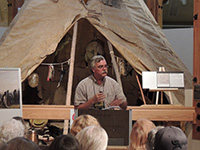 Jim Hardee, Editor of the Rocky Mountain Fur Trade Journal Jim Hardee, Editor of the Rocky Mountain Fur Trade Journal |
During the Rocky Mountain fur trade era, the American West saw the intersection of two worlds: thousands of Native Americans met hundreds of adventuring Euro-American fur trappers and traders. In 1837 at the annual rendezvous, a third culture arrived, represented by William Drummond Stewart. The Scottish nobleman sightseer was accompanied by Alfred Jacob Miller, an American artist trained in Europe. Both men are renowned among fur trade historians and enthusiasts. This summer during Green River Rendezvous Days in Pinedale, Wyoming, the Three Worlds Meet project commemorates the 1837 rendezvous through the art and adventures of Miller and his sponsor. |
Three Worlds Meet animates selected Miller paintings by staging tableaux vivants, costumed actors in sustained poses that imitate well-known artworks. The Three Worlds Meet script connects the tableaux through a narrative based on writings by Miller, Stewart and various trappers. It also incorporates the language and culture of Native Americans.
The program complements this volume of The Rocky Mountain Fur Trade Journal, which includes four articles or essays touching on aspects of Stewart's life and the historical legacy of Miller's artwork. These items were contributed by participants in the Three Worlds Meet project.
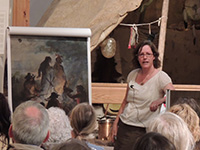 Lisa Strong, Art Historian Lisa Strong, Art Historian |
RMFTJ readers are familiar with the artwork of Alfred Jacob Miller, the only artist to have attended a Rocky Mountain rendezvous. Many historians use Miller's images as historical evidence of fur trade material culture. Art historian Lisa Strong maps the complexity of using Miller's art as a reliable source in Fact and Fancy in Alfred Jacob Miller's Early Watercolors, 1837-39. A leading expert on Miller, Strong insightfully compares various phases of the artist's career and illuminates the pitfalls of assuming that Miller's artwork can be considered historical data. |
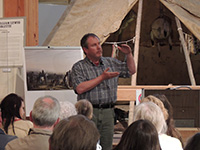 Scott Walker, Living History Interpreter Scott Walker, Living History Interpreter |
Scott Walker adds a resourceful postscript to Strong's article with Where Was Fort William? Walker examines Miller's paintings of Fort William (later known as Fort Laramie) for evidence of that structure's historical location. Though the original site is yet to be determine by archaeologists, Walker shows that careful attention to detail-- both in the artwork and Miller's commentary-- can yield interesting results. |
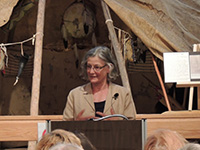 Kathleen Barlow, Anthropologist Kathleen Barlow, Anthropologist |
A painting by Alfred Jacob Miller forms the nucleus for Kathleen Barlow's investigation of domestic relations in Trappers' Brides: Intercultural Marriages in the Rocky Mountain Fur Trade. Barlow parses the fantasy and the reality in Miller's artwork to separate Euro-American assumptions about Native American women from the actual roles those women fulfilled in their societies. Ultimately, Barlow offers a way to re-frame Miller's images and writing to better appreciate Indian women's place in the Rocky Mountain fur trade. |
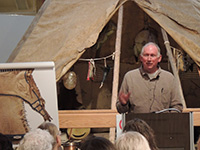 James C. Auld, Three Worlds Meet Project Director James C. Auld, Three Worlds Meet Project Director |
Murthly: Castle of the Rocky Mountain Fur Trade, by James C. Auld, is a glimpse into the personal life of Sir William Drummond Stewart that is anchored in the history of his ancestral home, Murthly Castle. Stewart came to the Rockies in 1833 and spent nearly a decade attending rendezvous, adventuring with fur trappers, and collecting artifacts. When he returned to Scotland, he renovated his ancestral home as a memento of his American experiences. Auld, who visited Murthly in 2006 and met with its current laird, gives readers an inside look at the man who brought Alfred Jacob Miller to rendezvous. |
Back issues of The Rocky Mountain Fur Trade Journal are available from the Sublette County Historical Society for $25 each plus postage. For more information, call 877-686-6266 or 307-367-4101 or purchase on-line at www.mmmuseum.com/tradingpost
Pertinent to this history, public presentations will also investigate and summarize the recently acquired letters of William Drummond Stewart, William Sublette and others at the Museum of the Mountain Man. Other source documents from Murthly Castle will be investigated. Speakers will describe how the three worlds were influenced by the exchange of cultures using academic discussions, living history demonstrations and interpretations, special exhibits and demonstrations of sign language and other non-verbal communication.




























